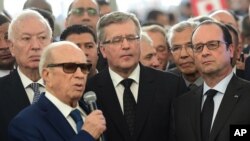Tunisian security forces said they have killed the main suspect in the deadly museum attack that targeted foreign tourists, as thousands took to the streets of the capital to denounce extremism.
Tunisia's state news agency TAP said Abou Sakhr Lokman was killed, along with eight others, late Saturday during an anti-terrorist operation in the Gafsa region near the Algerian border.
Officials said Lokman's group, which is affiliated with the North African branch of al-Qaida, organized the March 18 attack on the Bardo museum that left 21 foreign tourists and a Tunisian policeman dead.
Tunisia's Prime Minister Habib Essid said Sunday, “We have killed most of the leaders of Okba Ibn Nafaa who were behind many recent attacks. ... This is a clear and strong response to terrorism after the Bardo attack.”
On Sunday, tens of thousands of people took to the streets of Tunis to protest extremist violence in the country.
Leaders from several countries, including France and Italy, joined Tunisian leaders for the march from the seat of government at Bab Es-Saadoun to the museum.
A red-and-white sea of Tunisian crescent and star flags filled a major boulevard in Tunis where several world leaders, including French President Francois Hollande, planned to rally under the slogan “Le Monde est Bardo” (The World is Bardo).
“We have shown we are a democratic people, Tunisians are moderate, and there is no room for terrorists here,” said one of the demonstrators, Kamel Saad. “Today everyone is with us.”
Thousands of police and soldiers were positioned around the capital.
Mostly avoided violence
One of the most secular countries in the Arab world, Tunisia has mostly avoided violence in the four years since the toppling of autocrat Zine El-Abidine Ben Ali. In contrast with Libya, Yemen and Syria which have plunged into war and chaos, it has adopted a new constitution and held free elections.
But the Bardo massacre was one of the worst attacks in its history. Japanese, Polish, Spanish and Colombian visitors were among those killed in the attack, which the government says was aimed at destroying Tunisia's vital tourism industry.
“Tunisia wanted France with them, and France is on the side of Tunisia, the origin of the Arab Spring, and now a victim of a hateful act,” Hollande said in France after voting in local elections before flying to Tunis.
Italy's Prime Minister Matteo Renzi was also took part in the demonstration, along with leaders from Palestine, Poland, Belgium, Libya and Algeria.
Attackers
The Islamic State group claimed responsibility for the museum attack, though the Tunisian government has pointed the finger at Okba Ibn Nafaa, which has a base in the Chaambi mountains bordering Algeria.
The group was previously more allied to al-Qaida but has made vague statements on its position toward Islamic State, the al-Qaida splinter group that now controls large parts of Iraq and Syria.
The Tunis attack underscored how Islamist militant loyalties are blurring as they seek a new North African front, especially in Libya, where political chaos and factional fighting has allowed Islamic State to gain an outpost.
The two Bardo gunmen were trained over the border in Libya at camps operated by Tunisian militants, officials say. Both were killed by the security forces.










